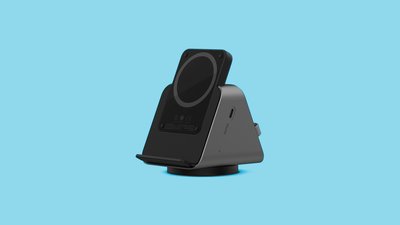Wireless charging works by utilizing electromagnetic induction to power up your devices, the charging pad produced magnetic field that ready to picked up by your devices 's coil, the same principle as technology used in induction stove. Wireless charging devices not limited to smartphone, it can be smart watch, wireless earbuds and other wearables, as long your devices mentioning wireless charging on the specification, although there is more to it that we will cover.
Standard
First to consider for choosing desktop wireless charger is the certification they use. Behind the wireless charging technology, there is a standard protocol that both the charger and your devices used, this standard protocol affecting how much power supply it can delivered, safety & protection, inoperability and some unique features.
Qi Standard
Qi is an open standard developed by the Wireless Power Consortium (WPC) and is the most widely used wireless charging standard today. Many manufacturers, including Apple, Google, Samsung, and Xiaomi, support Qi. If your device is Qi-certified, it will be listed as "Qi-compatible" in its specifications.
The first generation of Qi supported up to 7.5 watts of power, in 2023, Qi2 was released, offering faster 15-watt charging and new features that incorporate ring magnet to snap your device into perfect alignment as we seen previously with iPhone MagSafe, this features beneficial to improve charging efficiency and reducing heat caused by misalignment. However, it's important to note that the Qi2 and MagSafe magnet rings are not identical, which may affect backward compatibility. The Qi2 standard is expected to be mass adopted by Android devices in the near future.
A common question is whether iPhones can use the Qi standard. The answer is yes. iPhones from the iPhone 8 onward support Qi wireless charging, and starting with the iPhone 12, they are compatible with the Qi2 standard, allowing for charging speeds of up to 15 watts.
Most of renowned 3rd party brand such as Belkin, Anker, Ugreen incorporate this standard to their wireless charging dock/pad.
Proprietary Standard
Each brand may also have their own standard, built on top of Qi standard this proprietary standard usually promise to add more power to their compatible devices exclusively. for example, if you have the latest iPhone 16 and use it with an Apple MagSafe charger, you can achieve even faster charging speeds of up to 25 watts instead 15 Watt using Qi2 standard charger.
- MagSafe : Apple wireless charging proprietary standard, confusingly it also name for their MacBook wired charger.
- Samsung Proprietary Power Delivery Extension (PPDE) : is the technology that enables Samsung mobile devices to be fast-charged with the wireless fast charger. Samsung Wireless Fast Charge is a brand of Samsung PPDE technology.
In addition, other brands like Vivo, Oppo, Xiaomi, have also developed their own standards.
To clear things up, lets take a look at Xiaomi's wireless 80-watt charger, to be able to use its enormous 80-watt power delivery you need compatible Xiaomi smartphone models, if you use other model or device from another brand, the charger still works fine but at a limited max 15-watt power, as is also uses Qi2 standard. But remember your smartphone also have to Qi certified.
Charging Speed & Power Output
While we already covers power output a lot on previous section, Qi certified wireless chargers offer varying power outputs, typically ranging from 5W to 15W. Higher wattage can result in faster charging times, but it's crucial to match the charger's output with your device's capabilities. For instance, if your device supports 10W wireless charging, using a 15W charger won't necessarily speed up the process and may generate unnecessary heat.
For optimal wireless charging, devices need to be as close as possible to the charger. Thick or metal cases can interfere with the connection, making charging less effective or even preventing it altogether. This can also cause the charger to generate excess heat.
As a general rule of thumb, the ideal distance between your device and the charger should not exceed 3mm. Going beyond this distance can significantly impact charging performance.
Generally 10 watt charging speed means 2000mAh per hour in phone world. (10w/5v=2a). However the charging will likely slow down after a certain level of charge is reached so keep that in mind.
To gives you some ball park estimation of the charging speed take a look at table below
| Power | 3000 mAh Battery | 4000 mAh Battery |
|---|---|---|
| 5 Watt | ~ 180 Minutes | ~ 240 Minutes |
| 7.5 Watt | ~ 120 Minutes | ~ 156 Minutes |
| 10 Watt | ~ 90 Minutes | ~ 120 Minutes |
| 12 Watt | ~ 75 Minutes | ~ 100 Minutes |
| 15 Watt | ~ 60 Minutes | ~ 80 Minutes |
Some chargers require a fast-charging power adapter, which might be sold separately.
Multiple Charging
For added convenience, if you need to charge multiple devices at once, consider a charger with multiple charging pads. These chargers are often labeled as "2-in-1" or "3-in-1" devices, indicating their ability to simultaneously charge two or more items, such as a smartphone, smartwatch, or wireless earbuds. This feature can help reduce clutter and keep all your devices powered up in one place.
Keep in mind that the power output may not be equally distributed across all charging pads. Wearables like smartwatches and earbuds typically have lower battery capacities (mAh), so they require less power to charge. Meanwhile, devices like smartphones need higher wattage for faster charging. To ensure optimal performance, you'll also need a power adapter that can supply sufficient power to your charging dock, especially if you're charging multiple devices at once.
Design & Build Quality
When it comes to design, there are two distinct styles of wireless chargers available:
- Pad: This type is typically disc-shaped, allowing you to place your phone flat on it. While this design is simple and easy to use, it may not offer the best visibility for checking notifications or glancing at your screen while charging.
- Dock: A dock-style charger is more upright, often with a stand that props up your phone at an angle. This design offers better screen visibility, making it convenient for viewing notifications or using your phone hands-free while it charges. For the best ergonomics you want consider 60° stand angle, the face lock unlocks easier at this angle allowing for hands-free operation that allows you to work, study and enjoy entertainment on your device.
Some dock chargers allow you to place your smartphone in landscape orientation, which can be particularly useful if you want to watch media or use your phone for meetings while it charges. This flexibility makes dock chargers ideal for multitasking, as you can continue using your device comfortably without interrupting the charging process.
Speaking of material you might want consider more durable material like aluminum or high quality plastic, however if you also need portability to travel you might want a lighter material to choose.
Safety Feature
As the wired charger counterpart, safety features are crucial when choosing a wireless charger. Since wireless charging uses magnetic fields, interference can occur—for instance, if a metal object like a key is accidentally placed on the charging pad, it can generate excessive heat, potentially leading to dangerous situations. The more safety features a charger has, the better it is at protecting both your device and your environment. Below are key safety features to look for in wireless chargers:
| Feature | Desc |
|---|---|
| Overvoltage protection | Guards against sudden voltage spikes that could damage your device. |
| Under-voltage protection | Ensures your device continues to charge even with a temporary drop in power supply. |
| Over heating protection | Prevents the charger and device from overheating during use. |
| Reverse voltage protection | Protects against current flowing in the wrong direction, which could damage the charger or the device. |
| Overload protection | Prevents the charger from drawing too much current, which can lead to overheating or electrical failure. |
| Abnormal path impedance protection | Detects unusual resistance in the charging circuit to avoid damage or inefficient charging. |
| Overcurrent protection | Prevents the charger from delivering too much current, which could harm the device’s battery. |
| Static electricity protection | Safeguards against damage caused by electrostatic discharge. |
| Lightning protection | Shields the charger and connected devices from power surges caused by lightning strikes. |
| Electro magnetic field protection | Ensures the charger doesn’t emit harmful levels of electromagnetic radiation. |
| Foreign object protection | Detects and stops charging if a foreign object, like a metal key, is placed on the charging pad, preventing overheating or damage. |
Portability
Some chargers come with unique portability features that add convenience, especially for people on the go. For example, certain wireless chargers include an undocked charging pad that doubles as a power bank, allowing you to charge your devices wirelessly even when you're away from an outlet. Others offer foldable designs, making them compact and easy to pack, making them ideal for use as travel chargers. These versatile features provide added flexibility.
Additional Features
Some extra features you might want on a wireless charger are :
- LED indicators : to show charging status or indicate charging error, although some people might find its annoying when night charging
- USB ports: usually comes with a docked charger form, it allow us to charging additional devices with a cable.
- Cooling fans : for high output devices having cooling fans will help with heat dissipation.


